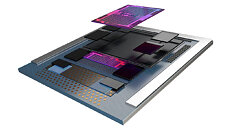
Unannounced AMD Instinct MI388X Accelerator Pops Up in SEC Filing
AMD's Instinct family has welcomed a new addition—the MI388X AI accelerator—as discovered in a lengthy regulatory 10K filing (submitted to the SEC). The document reveals that the unannounced SKU—along with the MI250, MI300X and MI300A integrated circuits—cannot be sold to Chinese customers due to updated US trade regulations (new requirements were issued around October 2023). Versal VC2802 and VE2802 FPGA products are also mentioned in the same section. Earlier this month, AMD's Chinese market-specific Instinct MI309 package was deemed to be too powerful for purpose by the US Department of Commerce.
AMD has not published anything about the Instinct MI388X's official specification, and technical details have not emerged via leaks. The "X" tag likely implies that it has been designed for AI and HPC applications, akin to the recently launched MI300X accelerator. The designation of a higher model number could (naturally) point to a potentially more potent spec sheet, although Tom's Hardware posits that MI388X is a semi-custom spinoff of an existing model.
AMD has not published anything about the Instinct MI388X's official specification, and technical details have not emerged via leaks. The "X" tag likely implies that it has been designed for AI and HPC applications, akin to the recently launched MI300X accelerator. The designation of a higher model number could (naturally) point to a potentially more potent spec sheet, although Tom's Hardware posits that MI388X is a semi-custom spinoff of an existing model.
























































